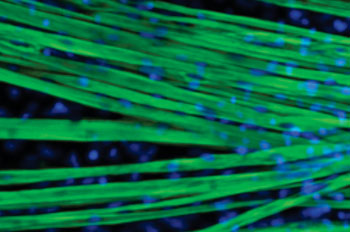Improved Stem Cell Technology Enables Mass Differentiation of Muscle Fiber Cells
By LabMedica International staff writers
Posted on 17 Aug 2015
Improvements in stem cell technology have enabled the in vitro differentiation and growth of large numbers of muscle fiber cells, including muscle fibers from a mouse model of Duchenne muscular dystrophy.Posted on 17 Aug 2015
During embryonic development, skeletal muscles arise from somites, which derive from the presomitic mesoderm (PSM). Using PSM development as a guide, investigators at Harvard University Medical School (Boston, MA, USA) were able to establish conditions for the differentiation of monolayer cultures of mouse embryonic stem (ES) cells into PSM-like cells without the introduction of transgenes or cell sorting.

Image: Micrograph of differentiated muscle fibers (green) with cell nuclei shown in blue (Photo courtesy of Dr. Olivier Pourquié, Harvard University Medical School).
The investigators showed that development of primary and secondary skeletal muscle could be recapitulated in vitro from the PSM-like cells, providing an efficient, serum-free protocol for the generation of striated, contractile fibers from mouse and human pluripotent cells.
Results published in the August 3, 2015, online edition of the journal Nature Biotechnology further revealed that mouse ES cells also differentiated into Pax7+ cells with satellite cell characteristics, including the ability to form dystrophin+ fibers when grafted into muscles of dystrophin-deficient mdx mice, a model of Duchenne muscular dystrophy (DMD). Fibers derived from ES cells of mdx mice exhibited an abnormal branched phenotype resembling that described in vivo, thus providing an attractive model to study the origin of the pathological defects associated with DMD.
“This has been the missing piece: the ability to produce muscle cells in the lab could give us the ability to test out new treatments and tackle a spectrum of muscle diseases,” said senior author Dr. Olivier Pourquie, professor of genetics at Harvard University Medical School. “We took the hard route: we wanted to recapitulate all of the early stages of muscle cell development that happen in the body and re-create that in a dish in the lab. We analyzed each stage of early development, and generated cell lines that glowed green when they reached each stage. Going step by step, we managed to mimic each stage of development and coax cells toward muscle cell fate.”
Related Links:
Harvard University Medical School














